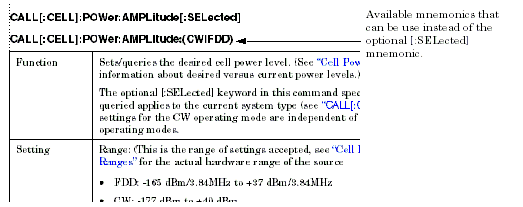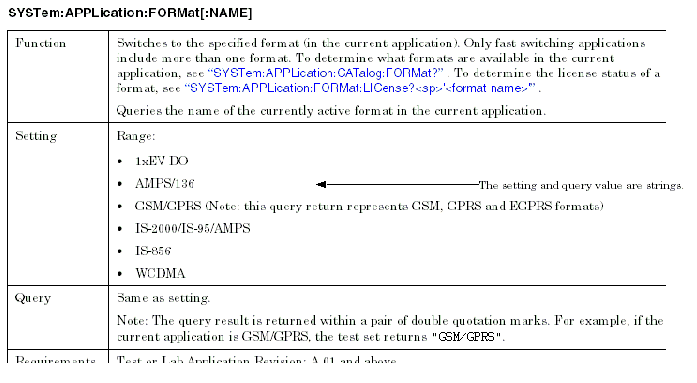GPIB Command Conventions
Last updated: January 16, 2009
Description
Command Description
The uppercase letters of a mnemonic represent the short form of the mnemonic, whereas the long form of a mnemonic is the short form followed by the lowercase letters. The test set accepts either the long form or the short form of the mnemonic.
The mnemonics that are inside square brackets are optional. That is, a command operates the same whether or not the mnemonic in square brackets is used in the command.
A vertical bar, |, implies choices. When mnemonics are listed in parentheses separated by vertical bars ( | ), you must choose one of the mnemonics inside the parentheses.
Complex Command Description
Complex commands are valuable because they set the state of the parameter and a value for that parameter. For example, a command that contains the mnemonic [:SAMPlitude] is a complex command that sets the state to ON as well as the amplitude. You can use parameters such as amplitude, frequency, gain, number, time, and value as a complex command. Refer to the specific command for the parameter that applies.
Data Type Description
Unit Type Description
Some commands have optional units of measurement. These are displayed in square brackets. If no units are specified in the command then the default unit in
bold font
below is used. The test set accepts the specified unit either with or without a space inserted between the <num value> and the unit (for example, both
10S
and
10 S
are valid). The following table summarizes the units available.
|
To set the spectrum monitor's timeout interval to 20 seconds, use any of the following formats: SETup:SMONitor:TIMeout:TIME 20 SETup:SMONitor:TIMeout:TIME 20S SETup:SMONitor:TIMeout:TIME 20 S |
||
[:SELected] Mnemonic
The [:SELected] Mnemonic is an optional mnemonic that implies a current selection on the test set. Often there are other mnemonics that can be used in place of the [:SELected] mnemonic to configure a setting that is not the currently selected configuration on the test set. The mnemonics that can replace the [:SELected] mnemonic are listed in parentheses separated by vertical bars ( | ) in the description table title. An example of a command that contains the [:SELected] mnemonic is shown in the following table.

Using quotes around strings
When the setting and query values of a GPIB command are strings, a single quote is needed around the strings when setting the command, while the test set returns the result in double quoted strings when querying.
OUTPUT 714;"SYSTem:APPLication:FORMat '1xEV-DO'"
OUTPUT 714;"SYSTem:APPLication:FORMat?" !The test set returns "1xEV-DO". Note here the strings are enclosed in double quote.
An example of a command that contains strings in the setting and query values is shown in the following table.
